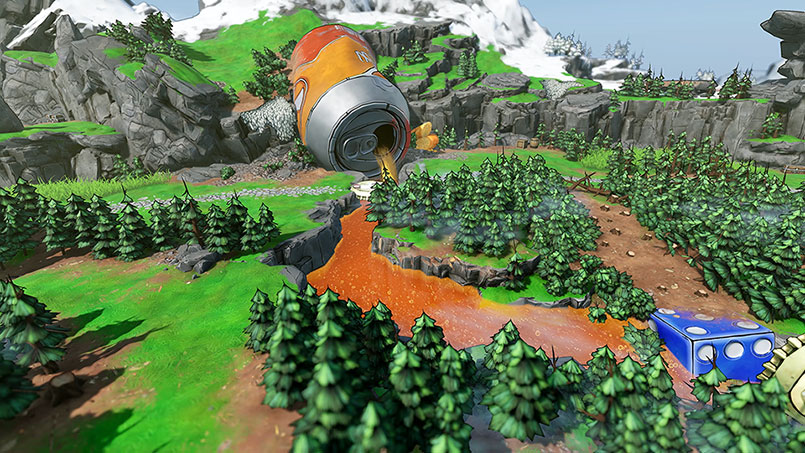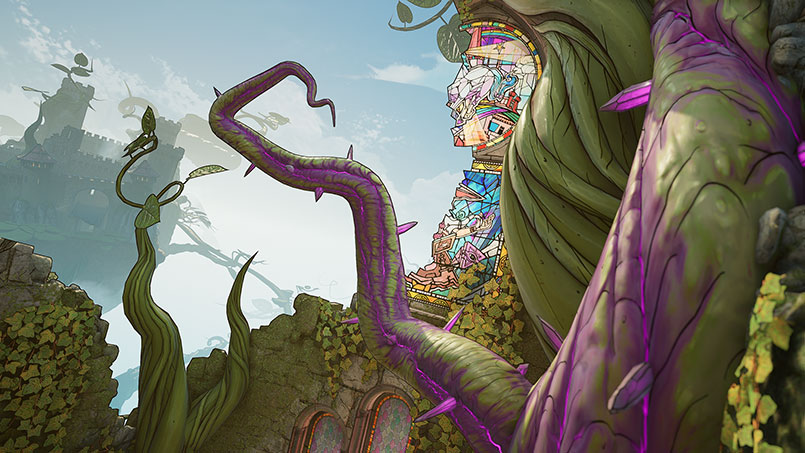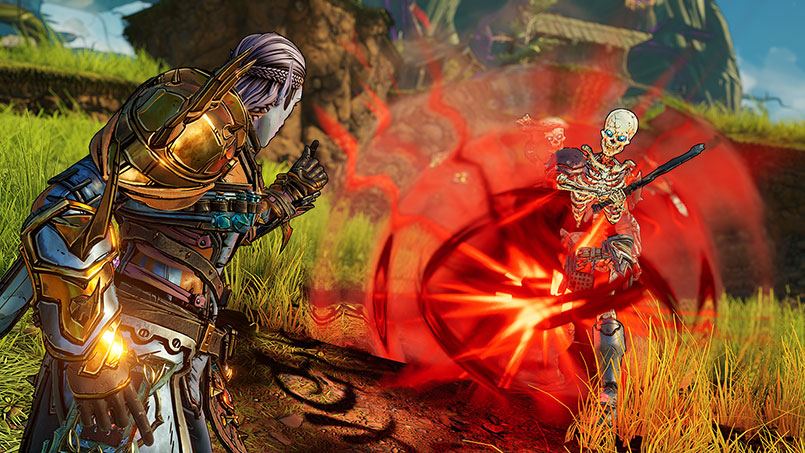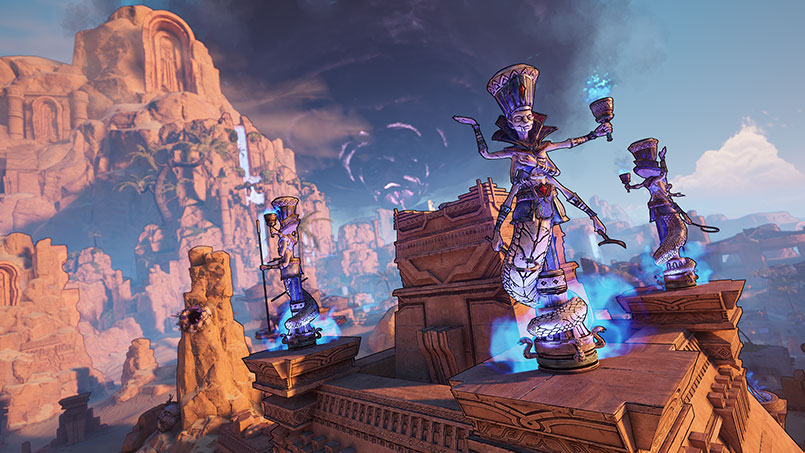Get the inside scoop from the developers on the Overworld exploration, enemy encounters, and more!
Tiny Tina's Wonderlands creative director Matt Cox knows a thing or two about channeling Tina's unbridled energy into the creation and razzle-dazzling of this most whimsical realm. "I think there's a Tina in all of us," says Matt. "At the very heart of our teams, we're all creatives—so we don't want to have a leash on that says 'This is a real-world scenario, so you can only do real-world things.' It's such a gift for creatives to be able to not have that tether. It's not very hard to create for Tina, because the crazy chaos that we all love to dream up exists in all of us—she's the perfect representative of pure design chaos."
Welcome one and all to the first in a series of Tiny Tina's Wonderlands Dev Diary articles, giving you a peek behind the Bunker Master's screen so you can get to know the developers who are bringing Tina's unpredictable adventure to life. Matt's here to walk us through some of the most fundamental elements of Tiny Tina's Wonderlands, so strap in and get ready for a crash course in how all this chaotic fantasy came to be.
YOUR ADVENTURING PARTY AWAITS
If the fantasy trappings, abundant dragons, and occasional giant dice throws weren't a dead giveaway, Tiny Tina's Wonderlands is heavily inspired by the tabletop games that many of us enjoy playing with friends and family. There's something enduringly magical about envisioning heroic deeds, fearsome foes, and dastardly villains with a table of allies by your side, all imagined via the guiding hand of a master storyteller.
As your humble Bunker Master, Tina is in control of your adventure through the Wonderlands—but you'll be hearing plenty from Valentine and Frette, your pals around the table. And of course, the more the merrier where multiplayer is concerned, whether your crew of up to four adventurers prefers cooperation of coopetition (in which loot drops are shared, and often stolen, amongst players).
"One of the best things about tabletop games in general is playing with your friends," notes Matt. "We definitely want to create that sensation in Tiny Tina's Wonderlands, and I think a lot of that has to come through with the table character dialogue and the performances of those characters. We have to feel like they bring a back-and-forth dynamic that really adds to the experience. So from the highest level possible, before you get into any of the big, gamey-game stuff—that's a technical term—you need to develop that social dynamic at the table."
The tabletop trappings are reinforced right from the get-go, as Tina enthusiastically encourages you to create a character sheet for the Fatemaker, a fully customizable hero of your personal design destined to fight for her royal majesty Queen Butt Stallion. It's not all about looks, either: you'll have to choose your class, like the sly Stabbomancer or the frost-wielding Brr-Zerker, and decide how to spend your Hero Points to pump up stats for survivability, adept spellcasting, and more. "We wanted to make sure that those options were plentiful enough and had the ring of what it feels like to create your own character, with the allocation of Hero Points and the multiclassing later on in the campaign," says Matt. "Being able to express yourself in the game was a giant goal that I think is another big inspiration from tabletop games."
AN OVERVIEW OF THE OVERWORLD
Early on in your shoot-and-loot adventure, you'll encounter another unmistakable nod to tabletop gaming: the Overworld, which gives you a third-person, bird's-eye-view of your character as they sprint around Tina's meticulously crafted game board (pay no mind to the haphazard popcorn kernels and that river of soda dribbling out of a tipped-over can). Here, the Fatemaker's heroic proportions are shrunken down to be adorably bite-sized, not unlike a painted miniature running amok in a tabletop realm.
"We went through a variety of iterations on the ideas of what that Overworld aesthetic was going to be," says Matt. "We even thought about making everyone look like figures on bases that moved with a back-and-forth waddling animation. But I think we landed on this idea of an exaggerated, scale-agnostic version of the Wonderlands, and it was important that players who put a lot of effort into their facial customizations and really tailor what their look is to be able to see that."
And thus, the chibi look of the Fatemaker in the Overworld came into focus. "Since the camera is so far back, we thought 'Let's give them the bobblehead look; let's just blow up their head!'" laughs Matt. "And when we did that, we realized 'This looks like a really cool bobblehead-type figure, but it also still animates beautifully.' Once we did the head-scaling to be so big, and with all the other scaling of how the environment looks, with all of the tabletop real-world stuff that's just on there because Tina didn't clean up her board, we really loved the synergy that everything created."
THE OVERWORLD IS YOURS TO EXPLORE
Once you've gotten used to the sight of your Fatemaker's big ol' noggin in the Overworld, you can start poking around the many nooks and crannies of the game board. Some discoveries might be minor—a quick dungeon encounter here, a smattering of gold-filled chests there—but you could end up stumbling onto an entirely optional area that some adventurers might miss altogether.
These aren't just flash-in-the-pan diversions, either: optional regions like the Tangledrift and the Sunfang Oasis are expansive environments complete with their own multi-part questlines. "We treat these huge maps like standalone modules from a tabletop game that feel different from the main quest," Matt explains. Braving these areas and completing their meaty side quests can help power you up before you take on the more difficult trials that await.
You may also encounter some collectibles in the Overworld tucked away in hidden corners, like Lucky Dice that increase your luck stat, helping you get item drops of better rarity. There are also Shrine pieces to collect that unlock passive boons when you've found all the needed pieces, and Poetry Pages scattered across the land that offer a bit more lore (read to you by the local bard in Brighthoof) for those seeking to map out the Wonderlands in their entirety. Knocking over bottle caps that litter the game board will create handy shortcuts that can reduce Overworld travel time if you ever need to backtrack.
Of course, exploring off the beaten path to find these optional areas is not without its perils. When trekking through stretches of tall grass or dense foliage, an enemy might pop out and charge at you, triggering a first-person shootout when they make contact. But if you're not in the mood for a fight right at that moment, you can simply punch them into oblivion and continue on your merry way.
"The player will always have agency on whether or not to engage with these random encounters; very seldom will it actually disrupt you," says Matt. "You're going to be fast enough to run away, or you can actually melee in the Overworld; you can melee the random encounter enemy before they touch you and they'll just explode, and you don't drop into the random encounter.
"But at the same time, we want the random encounters to be meaningful," he continues. "We want random encounters to make the player think 'Oh, I have an opportunity to go get this type of loot!' So we want random encounters to feel like a loot chest experience; the Christmas present or birthday present sensation of 'Ah, what a nice surprise!' From a design perspective, we're really trying to make random encounters something that the player wants to do rather than run away from. We've done a lot of work to eliminate that feeling of random encounters being a distraction."
OH, OH, OH, IT'S MAGIC
Alongside your ever-growing collection of trusty guns, shooting off spells is crucial to maximizing your damage output in Tiny Tina's Wonderlands, with most spells having short cooldowns that let you fire magic from your fingertips frequently. Some spells will make short work of enemies, roasting them with fire or sending them flying with a mini tornado; others offer more utility, like giving you and your allies a bit of protection or reduced cooldowns.
"The team has done a fantastic job of having fun first, especially with the spells," says Matt. "I think that's a hallmark of how we do things in our games, and particularly with Tiny Tina's Wonderlands—it's about having fun first before you start addressing balance. That doesn't mean balance isn't important, but I think players will have the most fun if we put it at the forefront. The things that are super out-there will probably become Legendary spells. It's a matter of getting all those crazy ideas out there first and then finding the right place for them in the rarity balance."
Wondering which spells Matt prefers to fling on the battlefield? "I love using companion classes, which go great with some of the different hydra spells that let you put little tiny hydras on the ground—their spewing attacks are so adorable and vicious. Having a pet class plus a bunch of hydras active via spells is pretty fun," he says.
SLICE, DICE, STAB, AND SLAM
Melee combat completes the combat trifecta of Tiny Tina's Wonderlands, as you're able to keep a dedicated melee weapon constantly equipped in addition to your guns and spell loadout. It's not likely to take precedence over the guns in your right hand and the powerful spells in your left, but weaving a few close-up strikes into the flow of your firefights can go a long way.
"It's very important for us that the pace of our style of shooter remains," says Matt. "And our style of shooter is very offense-focused; it's very forward-focused. It was important that our melee combat didn't use a lot of defensive parrying mechanics; there's nothing wrong with that, but it's not the style of play that fits the pace of combat we want. We also didn't want melee to replace shooting or upstage spells, because guns and spells are the two main modes of damaging enemies."
Instead of treating melee weapons—whether swords, axes, giant mallets, or more—as primary methods of attacking, smacking nearby enemies (like a bony member of the Skeleton Army) will stagger them to give you a bit of breathing room. You can keep tapping the melee button for a continuous series of swings if you're getting swarmed, and trying to melee an enemy that would otherwise be just out of reach will make you leap forward into a little glide-attack that closes the distance, which can be a crucial tactic for repositioning during an intense fight. "We wanted to make sure that melee was very accessible; it's still a one-button mechanic, but it has layers to it," explains Matt.
As you collect and equip progressively better melee weapons, you'll also notice some impactful modifiers that synergize with shooting and spellcasting. "For instance, a successful strike might reduce Action Skill cooldown or spell cooldown, or it can return ammo," Matt continues. "So if you're multiclassing and dialing in your Hero Points and your passives into spells and melee, maybe you're going to start choosing melee gear that returns spell cooldown to really optimize those relationships. For us, melee is still that secondary, offhand thing, but compared to our previous games, we want you to use melee more than you might've before."
You'll have a chance to perfect your mix of guns, spells, and melee in combat when Tiny Tina's Wonderlands launches on March 25, 2022. Until then, keep your eyes peeled for more Dev Diary articles and updates to the Tiny Tina's Wonderlands Game Guide as you plan your magnificent trip to the Wonderlands!




Write a comment